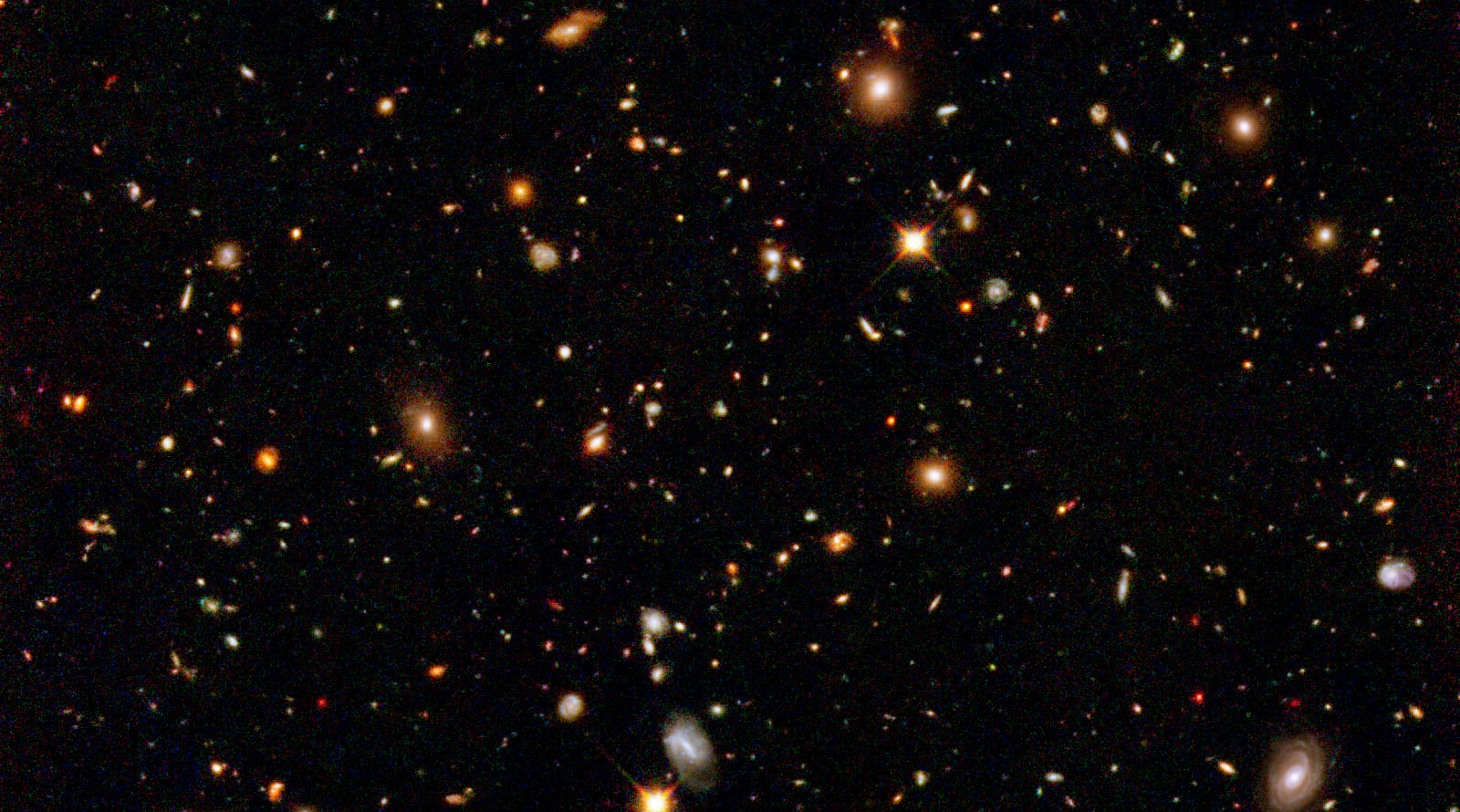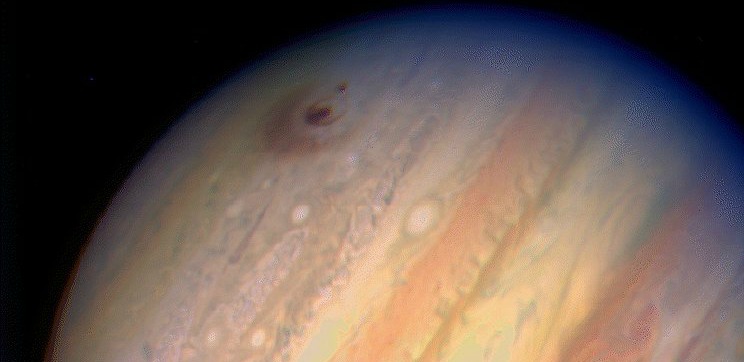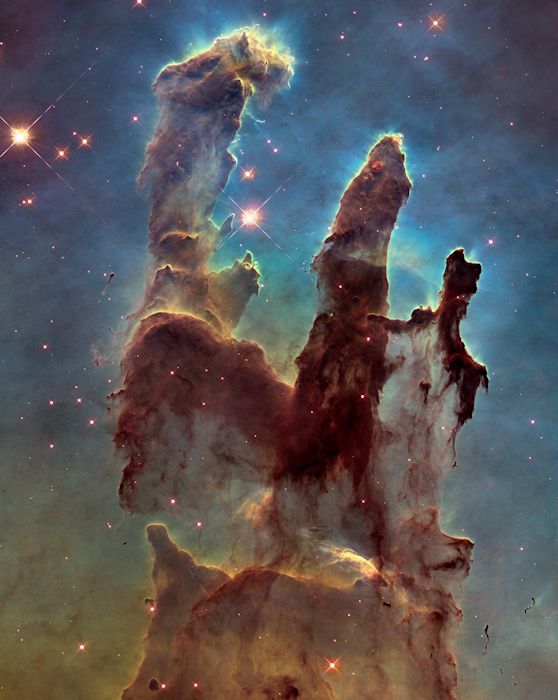How can something be both so familiar and so exciting? The Hubble Space Telescope’s images—of galaxies, star nurseries, black holes, and other celestial phenomena—are among science’s most famous. They appear on everything from calendars to coffee mugs. Yet, despite their prevalence in everyday life, these images still evoke awe. In the 21 years since the Hubble began producing images to its full capacity, they’ve had a profound effect on American culture and science.
Below, Pacific Standard collected thoughts from experts about the social impact of the Hubble’s photos. We’ve included excerpts from writing about the photos and from interviews we conducted.
1. THE HUBBLE IMAGES GAVE PEOPLE A WHOLE NEW SENSE OF THE VASTNESS AND COMPLEXITY OF SPACE
“The Hubble Deep Field, I think, is incredibly important for showing just the sheer quantity of galaxies that are out there. I show it to my students whenever I teach history of science classes. See all those little specks that are there in that image? Each of those little squiggles is a galaxy. That’s just mind-blowing.” —Patrick McCray
McCray is a professor of the history of modern science and technology at the University of California-Santa Barbara.

“Hubble definitely changed what the cultural mindset about what space was like. The picture of space that is painted now is far more interesting, far more complex, far more nuanced than it once was, and those changes actually do reflect a better understanding of what’s going on out there. It just changed the picture that people, including scientists, carry around inside their heads.” —Jeff Hester
Hester, a professor of astronomy at Arizona State University, led the science teams that created the “Pillars of Creation” photo, the Crab Nebula photo, and many other famed Hubble images.
2. THEY SHOWED PEOPLE THE DANGERS OF SPACE
“The images of the impact sites of the Comet Shoemaker-Levy 9 on Jupiter were a wake-up call for human beings that comets really do hit planets. It’s not just something astronomers dreamed up. There but for the grace of God go we.” —Michael Shara
Shara, a curator in the department of astrophysics at the American Museum of Natural History, previously worked at the Space Telescope Science Institute, which determines which astronomers get to conduct experiments using the Hubble Space Telescope every year.

3. THEY WERE PART OF AN IRRESISTIBLE AMERICAN COMEBACK STORY
“You know the Hubble Telescope was launched broken. It had a spherical aberration and for the first three and half years of its life, it still did very good science, but it was underperforming its design specifications quite severely.”
25 YEARS OF THE HUBBLE TELESCOPE
• How Hubble Changed Space: Hubble scientists reflect on how the famed telescope’s images impacted American culture and science.
• Images in Pop Culture: Hubble’s free images offer a big bang for zero bucks.
• The Pillars of Creation: What makes this photo so memorable?
“At the time the ‘Pillars of Creation’ image came out, I had been at the Space Telescope Science Institute for 10 years. Those had been some pretty bitter years. Suddenly, we had this thing come out. There was a lot of fist pumping. There was a lot of unbridled joy, because it showed what we really could do, what the telescope was really capable of. Then the science kept pouring out of the Hubble. It still remains the most productive and single most important telescope in the world.” —Michael Shara
“Of course everybody in the United States loves stories like that, of something that looked like it was down for the count and hey! It comes back.” —Patrick McCray

4. ASTRONOMY INSTITUTES HAVE ALWAYS KNOWN THE POWER OF ITS IMAGES …
“They’re great public relations tools. If you want to raise money for your observatory—or draw attention to the science that you’re doing—having attractive images to show to the general public, or to show to prospective patrons, is an incredibly useful thing to have.” —Patrick McCray
5. BUT HUBBLE’S HERITAGE PROJECT HARNESSED THAT POWER LIKE NEVER BEFORE
“Typically, interest in a scientific mission lasts for only a brief period—the duration of a mission or a few weeks of excitement after a new discovery—but decades after the telescope’s launch the Hubble images still made headlines and circulated widely online and in print. They achieved an almost unparalleled popularity within the history of astronomical images, even within the history of all scientific images….”
“Most people without advanced degrees in astronomy are hard-pressed to identify exactly how the Hubble Space Telescope has changed and enhanced humanity’s understanding of the cosmos. They have, however, seen many examples of the Hubble’s dramatic pictures, images that NASA showcases on its Web sites and that also appear on calendars and coffee mugs, album covers and art museum walls. Such pictures serve as visible evidence of the Hubble’s success. More than any notion of what astronomers do with the Hubble’s data, the stunning images account for the public’s support and affection for the telescope.” —Picturing the Cosmos: Hubble Space Telescope Images and the Astronomical Sublime, Elizabeth Kessler, 2012; read an excerpt at io9
6. THEY CHANGED AMERICAN SPACE MOVIES FOREVER
“The vivid backgrounds in 2014’s Guardians of the Galaxy are reminiscent of Hubble’s colorful photographs; in many scenes, outer space is alive with nebula-like swirling masses of red, purple, and gold. In comparison, many films that were released before Hubble—like the first three installments of Star Wars in 1977, 1980 and 1983—show space as mostly black sky with a few scattered stars. Hubble’s discoveries have transformed the silver screen, together with the public’s view of space: from black and void, to colorful and beautiful.” —”‘Hubble’—One Word Says It All” by Felicia Chou for NASA, April 10, 2015

7. …AND FOR THE BETTER, SCIENTIFICALLY
“You know the scenes in the movie Interstellar when they show the wormhole and the black hole? Those were actually real, full-up calculations of the general relativity going on in the vicinity of a black hole. What you were seeing on the screen there was a cutting-edge computer simulation. There’s still an awful lot of space opera out there, but there really has been a push in the direction of trying to show an image of space that is a little more like what we know it is, and I think the Hubble images had everything to do with that.”
“When you find yourself in a situation where the only real data you have is kind of meh, then you make stuff up. But when you find yourself in a situation where your real data are more compelling than what your artists are giving you, you end up saying, ‘Well, let’s show what it really looks like.'” —Jeff Hester
BONUS: WE ASKED HESTER IF THE PILLARS OF CREATION WOULD REALLY LOOK LIKE THAT IF SOMEBODY WERE TO VISIT IT
“The shapes and such that you would see would be what you see there. The colors would be more muted than the colors that you see. But the parts that are redder and yellower in the images would, in fact, appear redder and yellower to the eye. I won’t say that’s its true color, but it is closer to true color than if you took a picture with a color camera.”
“When you look at a nebula like this, there is light that is a very specific color that the eye sees really well, but that traditional photographic film cameras don’t see well at all. By the flip side of that, there is a kind of light the camera picks up well, but the eye doesn’t. A color picture would look garishly red, but if you looked at the Eagle Nebula through a telescope, you would see a lot of bluish and greenish with a yellow and red tint.” —Jeff Hester
Lead photo: The Crab Nebula, the result of a supernova. (Photo: NASA, ESA, J. Hester, A. Loll/Arizona State University)





